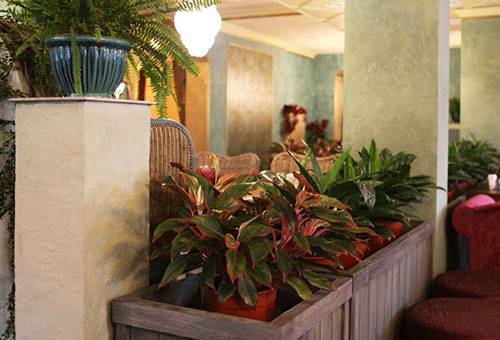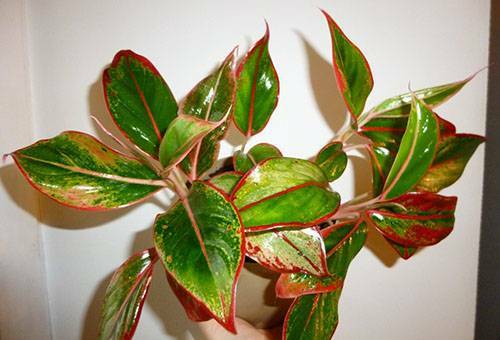Contents:
- Features of Aglaonema care
- What kind of lighting does Aglaonema like?
- Temperature for a plant
- Humidity
- How to water and feed Aglaonema?
- Transplant - how often?
- Choose the method of propagation of Aglaoneme
- Special problems and their solution
If you purchased Aglonaone as a houseplant - home care after it will not bring any difficulties or unpleasant surprises. This decorative-deciduous houseplant is considered one of the most unpretentious and reliable by the flower growers. It is appreciated for its beautiful leaves, covered with a variety of forms of spots, as flowers have no aesthetic value.

Features of Care for the Aglaonema
Any plant belonging to the genus Aglaonema is a rosette of large variegated leaves on a small stem. There are dwarf varieties, up to 15 cm high, like Aglaonema Pictum with velvety mottled leaves, and very large, like the aglaonema shiny with smooth green leaves - up to 45 cm "growth".The color of the leaves in this houseplant varies from the total absence of any spots to species with silvery stripes or yellow, creamy, pale green spots.
One of the most beautiful can be considered such achievements of breeders as Silver King and Silver Queen hybrids, which have silvery leaves. To Aglaonema retained its full decorative qualities, it is necessary to create conditions characteristic of its homeland - the humid tropics of Southeast Asia and the forests of India.

What kind of lighting does Aglaonema like?
Among the amateur flower growers, it is a common misconception that Aglaonema is very shade-tolerant and this quality is inherent in all of its species. However, this is true only for varieties with a single color of the leaves, and species with white spots on them in the shade lose much of their decorativeness, and hence the meaning of the cultivation of this plant is lost.
Aglaonema does not like direct sunlight, this alien from the rainforest fades from them, and the leaves fade. The most optimal can be considered such a mode of illumination, when most of the light day the plant receives scattered light, in the extreme case, you can let it be in the penumbra. By the way, winter illumination for aglonaemy is absolutely not necessary.
Temperature for plant
It does not tolerate this temperature lowering plant below 18 ° C.Better let it be warmer - up to 24 ⁰С.It is desirable to maintain such a temperature regime all year round, which is not at all easy on a cold winter window sill and under the scorching summer sun. In no case can not keep Aglaonema in a draft, this can even shake her famous unpretentiousness. So that the ventilation of the room through the window is canceled, as long as there is an aglaonema on the windowsill.
Tobacco( and any other) smoke to this plant is also contraindicated. What the famous botanist Dr. Hession had in mind, who claimed this was not entirely clear. Probably, it's not the place in the smoking rooms and shish kebabs. Well, we will take this as a given.

Humidity of air
This parameter for the inhabitant of the tropics is very important, it loves high humidity, especially in winter, when the rainy season begins in its homeland. At home, of course, we can not arrange such a season, but we can spray the flower from the atomizer with fine spraying and place it in a container with wet peat or expanded clay.
How to water and feed Aglaonema?
Watering abundantly in all seasons and seasons, except for winter: in the winter, watering is moderate and regular. Excess water from the pan should pour out, do not allow copious watering and stagnant water. Soft, settled water at room temperature is just what you need.
Board
Like all decorative deciduous, aglaonema needs regular wiping with a damp soft sponge once every two weeks.
Frequent fertilizing of the plant is also very like, especially with the predominance of nitrogen. The frequency of feeding is about 1-2 times a month. You can use the ready-made fertilizer for ornamental-deciduous plants in any form, liquid or granular.

Transplant - how often?
You do not need to transplant the Aglaonema often, it does not need constant changes of place of residence. It is enough to transplant an adult plant every three years, preferably in the spring. Young specimens are transplanted as they grow, and even if there is a need to increase the diameter of the pot.
Advice
If the composition of the soil does not satisfy, you can gently change the top layer of soil in the pot.
For the transplanted plant, it is necessary to prepare soil consisting of such components:
- humus - 1 part;
- peat turf - 1 part;
- sand - 1 part;
- sheet earth - 1 part.
At the bottom of the pot, drainage is laid, the roots of the plant are gently spread down and covered with cooked soil. The plant is watered with warm water, you can sprinkle it with "living water" - a solution of "Epin".At first, after transplantation, it is better not to put the plant in bright sunlight, but slightly to glaze the window glass.

We choose the method of propagation of the aglaoneme
The most simple and reliable way of reproduction can be considered the division of the bush. In spring, the shoots, having several leaves and roots, are carefully separated from the adult plant and immediately planted in a new place of residence.
The
Board The growth and root growth stimulators such as Kornevin, Zirkon and the good old "Epin" will help grow in a new place in the plant.
Aglaonema can be propagated by using root apical cuttings or lateral shoots, originally separated without roots. They are rooted in water, then planted according to the usual scheme. Such a method as seed propagation is theoretically possible, but in practice only an experienced floriculturist can obtain them.
If it was possible to purchase Aglaonema seeds, it is recommended to sow them in a mixture of peat and sand almost on the surface of the substrate. The container is sprayed from the sprayer, the crops are covered with a packet. After emergence of shoots, small plants are accustomed to the conditions of the room in which they will grow. To do this, the package is opened for a short time, and when 2-3 new leaves appear, they are transplanted into separate containers.

Special problems and their solution
The glory of an extremely unpretentious plant does not spare the care of the Aglaonema from problems and special difficulties. Here are the most common ones.
- Brown tips of shriveled leaves. The reason is too dry air.
- Twisting of leaves, brown edges. The reason is frequent drafts in the room.
- White inclusions, similar to pieces of cotton wool, in the axils of the leaves. The reason is mealy worm. Method of solution - treatment with a solution of laundry soap.
- A thin spiderweb on the underside of the leaves, small dry spots on them. The reason is the red spider mite. The method of solution is spraying with tobacco infusions, treatment with insecticacaricides.
Council
It is necessary to remove the aglaonema in the penumbra: the mite appears in very bright light.
The care rules for Aglaonema are very simple and easy to do. It is enough to maintain the optimum temperature and humidity of the air, regularly water and fertilize the plant, and it will acquire a well-groomed appearance, become an ornament of the interior.
Read article: How to store callas in winter



